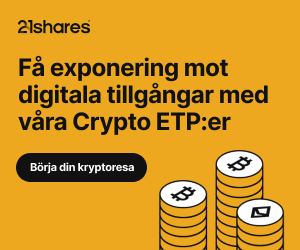Nyheter
Därför kan inte en ETF kollapsa
Publicerad
10 år sedanden

Därför kan inte en ETF kollapsa I en artikel som skrevs 2010 av Andrew Bogan, VD för en Bostonbaserade kapitalförvaltare, nämns den ångest som ibland kan drabba ETF-investerare, och sprida oro för strukturen på börshandlade fonder. Bogans ”forskning” försökte gräva i en av de mindre nämnda differentierande egenskaper hos börshandlade fonder: förmågan att sälja dessa värdepapper kort, och de potentiella konsekvenserna av en massiva blankning av en ETF. Hans slutsatser målade upp en ganska skrämmande bild för de investerare eller rådgivare som arbetar med ETFer. Frågan är emellertid om Bogan hade rätt eller om hade han missförstått det hela? Därför kan inte en ETF kollapsa är således en ganska bra text att ta till sig eftersom vi är av den åsikten att en börshandlad fond är betydligt säkrare än många andra investeringsprodukter på marknaden.
Domedagsscenario
“While ETFs often appear to be a benign innovation as compared to some of Wall Street’s arcane derivatives, a closer look at the mechanics of short selling ETFs (which have become one of the most prevalent securities to short) raises some serious concerns,” skriver Bogan.
Han noterade att betydande blankningar i vissa börshandlade fonder kan skapa en situation där antalet andelar i en ETF kan vara större än vad som har getts ut av emittenten. Han åskådliggjorde detta med SPDR Retail ETF där det vid ett tillfälle hade blankats mer än fem gånger så många andelar som emittenten hade gett ut, 95 miljoner blankade andelar i denna börshandlade fond att jämföra med de 17 miljoner andelar som utgivaren hade emitterat.
Artikeln fortsatte sedan med ett domedagscenario där författaren beskrev en våg av inlösen av andelar i en hårt blankad ETF och hur denna skulle leda till att fonden kollapsade. Bogan skriver att en begäran om inlösen av 17 miljoner andelar i XRT skulle leda till att denna ETF skulle stänga, vilket skulle leda till att de som hade blankat de övriga 78 miljoner andelarna i denna börshandlade fond inte skulle behöver täcka dem.
“Extend this hidden unfunded liability from massive scale short-selling of ETFs (both traditional and naked) across the entire ETF spectrum and it is a $100 billion potential problem.”
Finns den anledning att oroa sig?
Detta är skrämmande, speciellt när det kommer från en man med en Ph D som driver en kapitalförvaltningsfirma. Efter det att CNBC och ett antal större medier plockade upp denna historia, något som de gjorde utan att ha kontrollerat fakta i en större utsträckning, så ledde detta till oro från till och med etablerade ETF-investerare. Bogans artikel är välskriven men den missar en del mycket viktiga saker när det gäller börshandlade fonder. Bogan har helt enkelt inte förstått hur en ETF fungerar.
I verkligheten finns det ingen som helst möjlighet för en kollaps när det gäller vare sig XRT eller någon annan ETF. Det finns faktiskt en relativt enkel förklaring till varför detta inte kan inträffa.
Här är varför du inte behöver oroa Dig
För det första behöver vi förklara hur det kan uppstå en situation när det finns stora blankningar i en börshandlad fond. Ett förenklat exempel på sex separata transaktioner bidrar till att förklara hur denna situation kan uppstå:
- Transaktion # 1: En auktoriserad marknadsaktör (AP1) överlämnar en korg aktier till ETF-utgivaren. I utbyte mot detta erhåller AP1 50 000 andelar i den börshandlade fonden.
- Transaktion # 2: En insititutionell investerare (II1)köper 50 000 andelar i den börshandlade fonden av AP1, och får leverans av dessa.
- Transaktion # 3: En andra insititutionell investerare (II2) köper 50 000 andelar i den börshandlade fonden av en annan auktoriserad marknadsaktör (AP2).
- Transaktion # 4: För att kunna leverera dessa andelar till II2 lånar AP2 50 000 andelar från II1 som då får en ersättning av AP2 för att låna ut dem.
- Transaktion # 5: Samtidigt köper en privatkund (PK1) 50 000 andelar av den första auktoriserade marknadsaktören (AP1).
- Transaktion # 6: AP1 har inga andelar att leverera i detta ögonblick, men lånar i sin tur dessa av den andra insititutionella investeraren (II2).Nettot är att både AP1 och AP2 har blankat 50 000 andelar i den börshandlade fonden, sannolikt mot ett innehav som mostvarar tillgångar i form av aktier som överensstämmer med innehavet i denna ETF. Det betyder emellertid att de finns 100 000 blankade andelar i denna ETF, mer än dubbelt så många som har utfärdats av ETF-emittenten. Gör detta ett par gånger under en intensiv handelsdag så är det inte helt orimligt att anta att de blankade andelarna uppgår till mer fem gånger det antal andelar som ETF-utgivaren har emitterat.
Som beskrivet ovan, de auktoriserade marknadsdeltagarna som är involverade i denna kedja kommer att vilja hedga sig, de kommer vilja säkra de andelar som de säljer genom att köpa en korg av underliggande aktier som en kompensation för de blankade andelarna. Denna korg kan sedan lämnas till ETF-utgivaren i utbyte mot andelar i den börshandlade fonden.
Ett felaktigt resonemang
Nu när vi har förklarat utvecklingen av nettokort position är det relativt lätt att förstå varför en ETF inte kan kollapsa. De siffror om korta positioner, det vill säga blankningar, som fanns i XRT är 100 procent korrekt, och det finns ett antal ETFer med betydande korta nettopositioner. Bogan underlåter emellertid i sin analys att undersöka nyanserna i skapandet/inlösenprocess som sattes på plats för att skydda ETF investerare mot en körning på en fond.
Oron för att en inlösenvåg skulle leda till en likvidation av en börshandlad fond, vilket skulle leda till att de investerare som köpt andelar från blankare skulle lämnas lottlösa är således obefogad. Bogan har ignorerat det faktum att inlösen och skapandet av nya andelar kräver settlement. Med andra ord måste det finnas tillgång till andelarna i en börshandlad fond innan de kan lämnas över till ETF-utgivaren för inlösen. I samband med inlösen måste den auktoriserade marknadsaktören ange att andelarna inte är utlånade. Är de utlånade kan de inte lämnas över till ETF-utgivaren.
Vi gräver vidare
Exemplet ovan visar att de 50 000 andelarna i den börshandlade fonder inte skulle kunna lösas in förrän de korta positionerna har stängts, det vill säga innan de har lämnats tillbaka till den som har lånat ut dem. Låt oss nu anta att de institutionella placerarena II1 och II2 vill ha tillbaka de andelar de har lånat ut till de auktoriserade marknadsaktörerna. Dessa skulle då helt enkelt skapa ny a andelar. Betänk, dessa aktörer äger ofta de underliggande aktierna i syfte att säkra sin exponering och kan då med de nya andelarna betala tillbaka de andelar som de lånat från de institutionella placerarna.
I avtalen för de auktoriserade marknadsaktörerna anges uttryckligen detta krav. Följande är hämtat från XRT Statement of Additional Information:
Texten ovan visar att Bogan inte var den första som trodde han kommit på något som alla andra missat. ETF emittenterna har insett detta sedan länge, och har av den anledningen utarbetat lösningar för att se till att investerarna kan upprätthålla förtroendet för ETF strukturen
Slutsats
På ytan är ETFer är mycket enkla fordon som möjliggör för investerare att på enkelt och effektivt bygga långsiktiga portföljer, eller göra en kortsiktig satsning på en bred variation av tillgångsklasser. Tittar vi närmare på hur en börshandlad fond är konstruerad så ser vi ett antal komplexa mekanismer som ser till att allt fungerar. Därför kan inte en ETF kollapsa
Den senaste tidens spridning av desinformation om ETF strukturen fungerar som en värdefull påminnelse för investerare att de måste göra sina läxor och förstå detaljerna i de olika investeringsinstrument som finns tillgängliga, och förhoppningsvis som en påminnelse till medierna för att kontrollera fakta innan sprida panik.
Du kanske gillar
-


Hur är en ETP strukturerad?
-


Stora institutioner köper medan privata investerare dumpar sina aktiefonder
-


Spelar priset på en ETF någon roll?
-


Utlåning av börshandlade fonder: En ännu mer lukrativ metod än värdepapperslån?
-
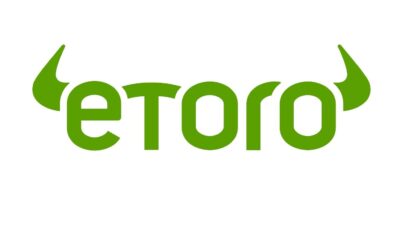

eToro låter dig köpa aktier utan courtage
-


Roundhill lanserar Wall Street Bets fond
Nyheter
From digital asset to safe haven: Why is Bitcoin acting like gold?
Publicerad
14 timmar sedanden
28 april, 2025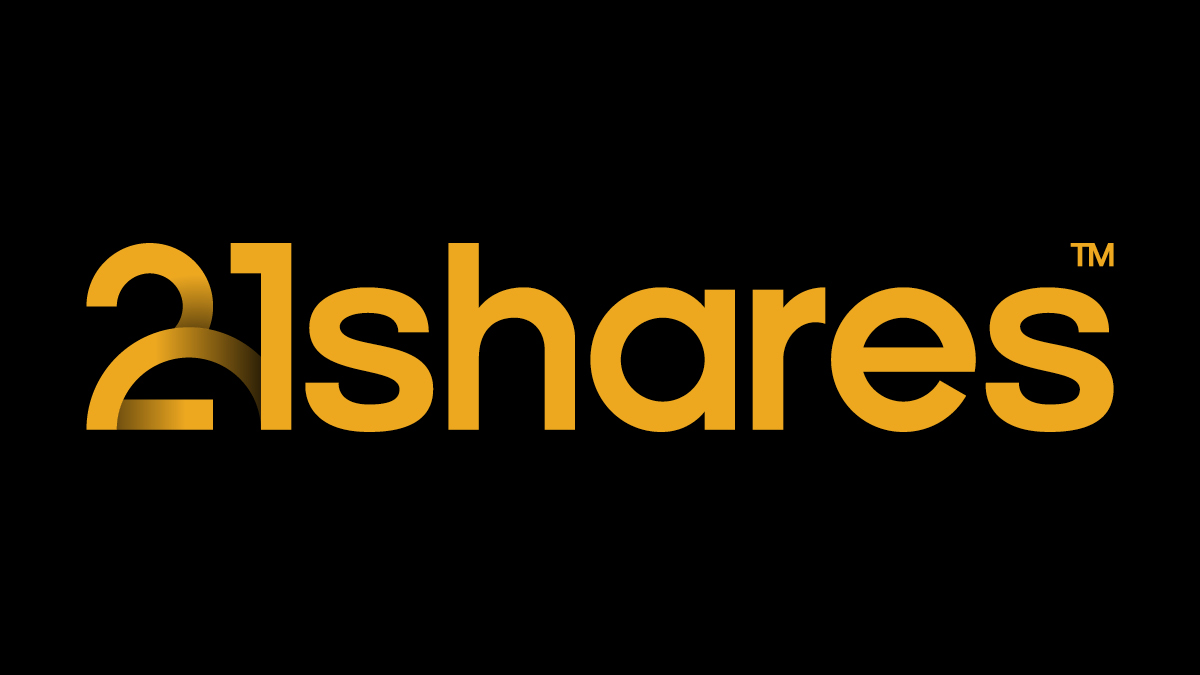
Bitcoin’s price has taken a different path from U.S. stocks over the past weeks. While major indexes such as the S&P 500 and Nasdaq have experienced declines, Bitcoin has risen to its highest levels in recent months, positioning itself as a safe haven, similar to gold. Understand how Bitcoin and gold have been synced for some time and what the correlation might look like in the future.
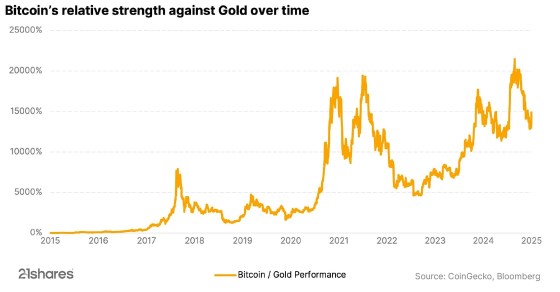

Ethereum’s big reboot: Why investors should be excited
Ethereum is making headlines due to a potential change in its core software, the Ethereum Virtual Machine (EVM), that operates across thousands of computers, enabling Ethereum to execute smart contracts and securely track transactions. However, Ethereum’s co-founder, Vitalik Buterin, has suggested replacing the EVM with a new system called RISC-V. Discover why the change is necessary and its potential impact on investors.
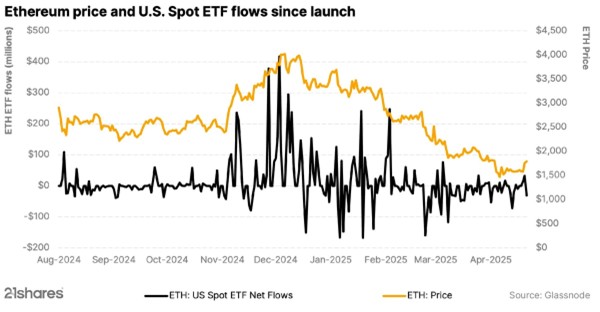


Thousands of altcoins, but no altcoin season: What comes next?
Over the past year, the crypto market has entered a new era. Bitcoin hit new all-time highs, outperforming other cryptocurrencies and decoupling from the stock market. Unlike previous cycles, the expected “altcoin season” did not occur, with Bitcoin remaining strong and money not flowing into other cryptocurrencies or altcoins. So, the big question is: Has altcoin season run its course?
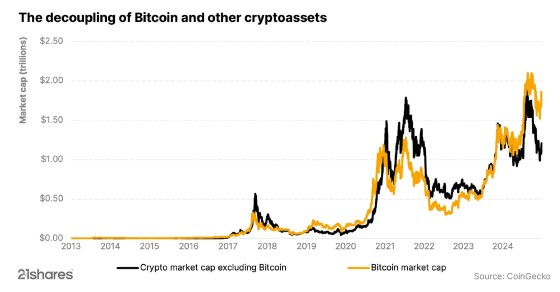

Research Newsletter
Each week the 21Shares Research team will publish our data-driven insights into the crypto asset world through this newsletter. Please direct any comments, questions, and words of feedback to research@21shares.com
Disclaimer
The information provided does not constitute a prospectus or other offering material and does not contain or constitute an offer to sell or a solicitation of any offer to buy securities in any jurisdiction. Some of the information published herein may contain forward-looking statements. Readers are cautioned that any such forward-looking statements are not guarantees of future performance and involve risks and uncertainties and that actual results may differ materially from those in the forward-looking statements as a result of various factors. The information contained herein may not be considered as economic, legal, tax or other advice and users are cautioned to base investment decisions or other decisions solely on the content hereof.
Nyheter
WELC ETF ger exponering mot företag inom sällanköpsvaror
Publicerad
15 timmar sedanden
28 april, 2025
Amundi S&P Global Consumer Discretionary ESG UCITS ETF DR EUR (D) (WELC ETF) med ISIN IE00061J0RC6, strävar efter att spåra S&P Developed Ex-Korea LargeMidCap Sustainability Enhanced Consumer Discretionary index. Det S&P-utvecklade ex-Korea LargeMidCap Sustainability Enhanced Consumer Discretionary-indexet spårar stora och medelstora företag från den diskretionära konsumentsektorn. ESG-kriterier (miljö, social och bolagsstyrning) beaktas vid valet av värdepapper.
Den börshandlade fondens TER (total cost ratio) uppgår till 0,18% p.a.. Amundi S&P Global Consumer Discretionary ESG UCITS ETF DR EUR (D) är den billigaste ETF som följer S&P Developed Ex-Korea LargeMidCap Sustainability Enhanced Consumer Discretionary index. ETFen replikerar det underliggande indexets prestanda genom fullständig replikering (köper alla indexbeståndsdelar). Utdelningarna i ETFen delas ut till investerarna (Årligen).
Amundi S&P Global Consumer Discretionary ESG UCITS ETF DR EUR (D) är en mycket liten ETF med 5 miljoner euro förvaltade tillgångar. Denna ETF lanserades den 20 september 2022 och har sin hemvist i Irland.
Investeringsmål
AMUNDI S&P GLOBAL CONSUMER DISCRETIONARY ESG UCITS ETF DR – EUR (D) försöker replikera, så nära som möjligt, resultatet för S&P Developed Ex-Korea LargeMidCap Sustainability Enhanced Consumer Discretionary Index (Netto Total Return Index). Denna ETF har exponering mot stora och medelstora företag i utvecklade länder. Den innehåller uteslutningskriterier för tobak, kontroversiella vapen, civila och militära handeldvapen, termiskt kol, olja och gas (inkl. Arctic Oil & Gas), oljesand, skiffergas. Den är också utformad för att välja ut och omvikta företag för att tillsammans förbättra hållbarhet och ESG-profiler, uppfylla miljömål och minska koldioxidavtrycket.
Handla WELC ETF
Amundi S&P Global Consumer Discretionary ESG UCITS ETF DR EUR (D) (WELC ETF) är en europeisk börshandlad fond. Denna fond handlas på flera olika börser, till exempel Deutsche Boerse Xetra.
Det betyder att det går att handla andelar i denna ETF genom de flesta svenska banker och Internetmäklare, till exempel Nordnet, SAVR, DEGIRO och Avanza.
Börsnoteringar
Största innehav
Denna fond använder fysisk replikering för att spåra indexets prestanda.
| Namn | Valuta | Vikt % | Sektor |
| AMAZON.COM INC | USD | 18.89 % | Sällanköpsvaror |
| TESLA INC | USD | 13.29 % | Sällanköpsvaror |
| HOME DEPOT INC | USD | 5.75 % | Sällanköpsvaror |
| LVMH MOET HENNESSY LOUIS VUI | EUR | 5.44 % | Sällanköpsvaror |
| TOYOTA MOTOR CORP | JPY | 4.58 % | Sällanköpsvaror |
| MCDONALD S CORP COM NPV | USD | 2.63 % | Sällanköpsvaror |
| LOWE S COS INC COM US 0.50 | USD | 2.38 % | Sällanköpsvaror |
| SONY GROUP CORP (JT) | JPY | 2.25 % | Sällanköpsvaror |
| BOOKING HOLDINGS INC | USD | 2.02 % | Sällanköpsvaror |
| TJX COMPANIES INC | USD | 1.89 % | Sällanköpsvaror |
Innehav kan komma att förändras
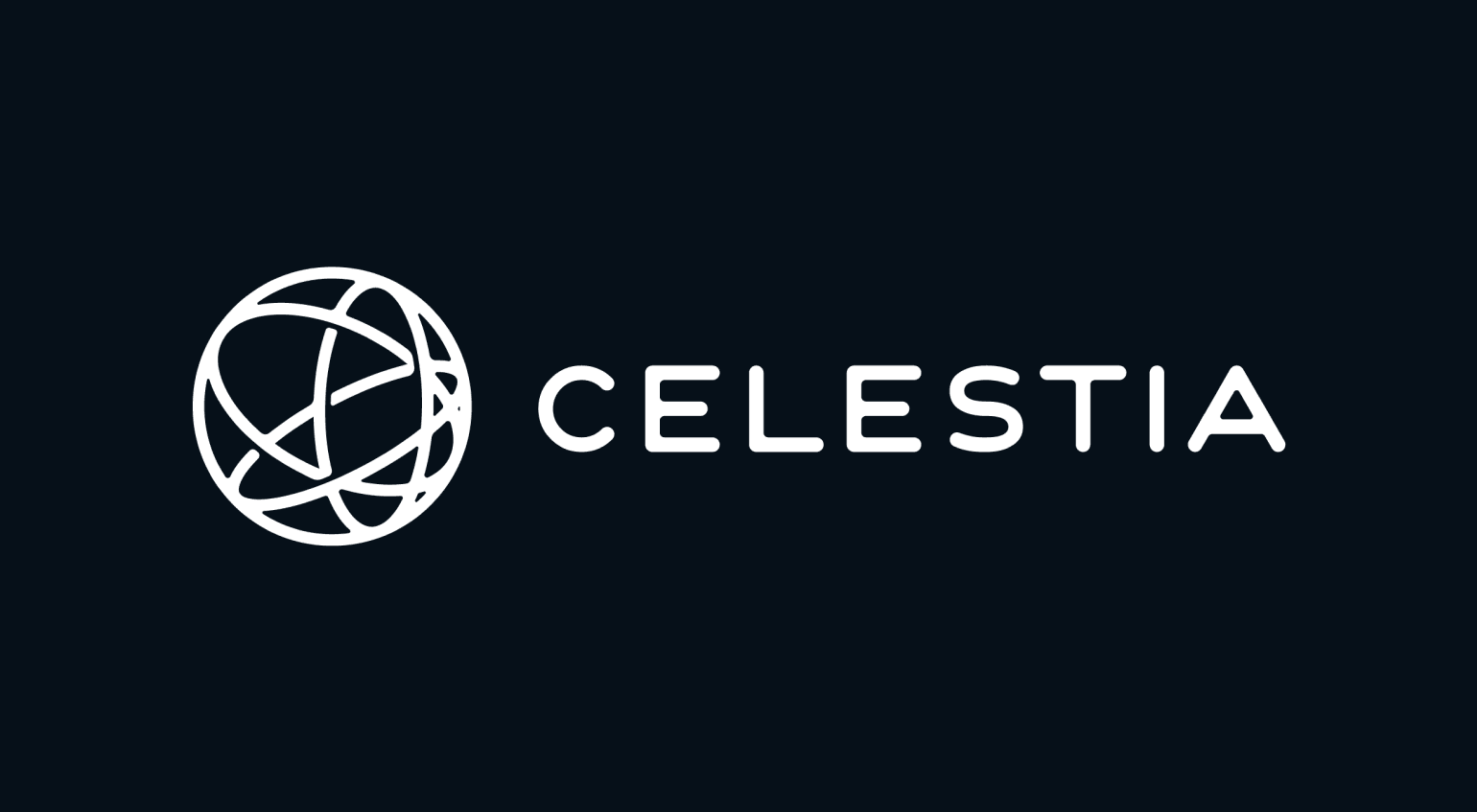
To understand Celestia’s value and its role in the ecosystem, it’s helpful to first understand how traditional blockchain systems are structured.
Most blockchains, like Ethereum or Bitcoin, are monolithic which means they perform all major functions (consensus, data availability, and execution) on a single layer. This design ensures security but according to new modular networks, limits scalability and flexibility.
The modular blockchain thesis, which Celestia is leading, proposes separation of layers and respective responsibilities in the network. Instead of having one network and its validators perform all of its functions, it may be better to have specialized layers:
• Consensus Layer: Ensures that all nodes agree on the order of transactions.
• Data Availability Layer: Ensures transaction data is accessible to all participants.
• Execution Layer: Processes the actual logic and computation of smart contracts.
By unbundling these components, developers can build more efficient, flexible systems that scale far beyond what monolithic blockchains can support. Not all applications need similar levels of security and not all applications need to scale up to millions of transactions. Additionally, one application might be scaling beyond the capabilities of its host network, severely effecting the available data throughput of other applications. This limits developers to the monolithic technology stack provided by a virtual machine such as Ethereum’ EVM.
The Issue of Data Availability
One of the most misunderstood yet crucial components of any blockchain is data availability. In simple terms, it ensures that the data behind each block is fully accessible and verifiable by all participants in the network. Another way to describe it is as the confidence a user can have that the data required to verify a block is really available to all network participants. Data availability is therefore important to all stakeholders of the blockchain ecosystem.
If a block producer withholds data, then nodes cannot verify the block, which leads to potential censorship or fraud.
Traditionally, a blockchain network can offer data availability with the following mechanisms:
• Full Replication: Every node stores the entire blockchain and verifies all data. Secure but not quite scalable.
• Sharding: Breaks the blockchain into smaller pieces (shards), spreading data across nodes. Scalable but highly complex to implement.
• Committee-Based Models: Small groups of nodes are trusted to verify data availability. Efficient, but less decentralized.
Celestia takes a completely different approach using a novel method called Data Availability Sampling (DAS). Instead of requiring every node to download all data, DAS allows lightweight nodes to randomly sample small chunks of a block. If enough pieces are retrievable, the node can confidently assume the full block is available. This slashes resource requirements while maintaining security and decentralization.
Why Data Availability Matters
Data availability might sound like a nerdy technical term, but it’s one of the most important yet one of less invisible parts of how blockchains work.
Let’s say you’re using a crypto app to trade tokens, store art, or move money. Every time you do something, that action (also referred to as a transaction) needs to be recorded and shared with the rest of the network so everyone agrees it happened. If that data disappears or can’t be verified, the whole system becomes untrustworthy. You might think your tokens moved but if no one else can see that record or a different version of that record, it’s as if it never happened.
Here’s a real-life parallel: imagine a public scoreboard at a sports game. If the scorekeeper shows the score to only a few people and then hides the board, how can the rest of the crowd trust the result? Everyone needs to see the score to believe it’s fair. In crypto, data availability is what makes sure the scoreboard is always visible to all participants at any time.
How DAS Changes the Game
Traditionally, ensuring data availability meant every node had to download and verify the entire block of data for any purpose related to particular data inside the block, like reading a whole newspaper just to check one article. Ethereum and most competing monolithic layer-1’s operate this way. It works, but it’s expensive, slow, and becomes less practical as blockchains scale in terms of data throughput required by its Dapps therefore limiting the types of applications that developers can build.
Celestia’s Data Availability Sampling (DAS) is a breakthrough that lets even simple devices (like smartphones) verify that a block’s data is available—by checking just a few random pieces. If enough pieces are found and correct, the network can be confident the full block is truly there and correct.
This innovation means:
• Light clients can safely participate in the network without downloading everything.
• Rollups and app-chains can post their data to Celestia with minimal overhead.
• Scalability skyrockets without sacrificing decentralization.
Celestia’s Role in Scaling Applications
Celestia is the first blockchain designed specifically to be a modular data availability layer. That means it doesn’t execute smart contracts or handle transactions directly, instead, it provides a foundation for others to build new networks, also referred to as rollups.
Developers can launch rollups or full execution environments, and use Celestia to handle the consensus and data availability side. This unlocks several key benefits:
• Massive scalability: Apps can scale independently from each other.
• Customization: Developers choose their own virtual machines, consensus mechanism and execution logic.
• Decentralization: Thanks to DAS, even small devices can validate the system.
This approach flips the script on how we think about launching and scaling blockchains. Instead of competing for space on a monolithic chain, apps get their own chains, backed by Celestia’s secure and scalable data availability layer while giving developers full stack control over their applications.
Celestia Enables Scalability and Offers Full-Stack Control
Using the restaurant example from Sui vs Aptos. Imagine a big, busy restaurant where the chefs, waiters, and cashiers all work in the same small kitchen. It gets crowded, orders take forever, and sometimes things go wrong while the backlog of orders keeps growing. That’s how traditional blockchains work, doing everything in one place.
Now imagine if the restaurant separated the jobs: the chefs cook in a big kitchen, waiters serve from a clean dining area, and the cashiers handle payments at the front desk. Everything runs smoother, faster, and the restaurant can grow in a environment that is less prone to congestion. That is what Celestia is doing for blockchains. Let’s say a small specialty restaurant opens up next door, leveraging Celestia’s register and order management system. That new restaurant can fully focus on delivering the best food and experience to customers, knowing that Celestia’s technology won’t be the limiting factor when scaling up their kitchen. The modularity that Celestia’s restaurant offers is allowing a lot of small scale restaurants to exist without the overhead of individual administrative work. It goes even a step further, Celestia allows you to just use it register while letting smaller restaurants pick their own kitchen (execution environment) and order management system (consensus layer).
In conclusion, Celestia is challenging the believe that blockchains should always be monolithic and blockchains need to offer the same technology stack to all developers on its chain. It is a significant leap forward in the crypto ecosystem and opens possibilities that were previously not feasible.
Diversify Crypto Exposure to Modular Blockchain Technology with the VanEck Celestia ETN
Key features of the VanEck Celestia ETN
• Celestia enables secure scaling of blockchain applications with modular technology.
• Fully-collateralized by TIA in cold-storage.
• Total return of TIA: Tracks the MarketVector™ Celestia VWAP Close Index (MVTIAV).
Why VanEck Crypto ETNs? Here’s why:
• With nearly 70 years in asset management and a strong track record in crypto, we bring deep industry knowledge and proven reliability.
• We combine traditional financial strengths with cutting-edge crypto innovation, backed by a CEO who truly believes in crypto’s future.
• We ensure clarity in our product structures and avoid high-risk or opaque practices, with assets fully backed by cryptocurrency in secure cold storage.
• Our assets are secured by a licensed European bank in Liechtenstein, providing top-tier compliance and security.
• We use the safest institutional custody setup available, prioritizing your security over cost savings.
Crypto is an asset class with high potential returns but investing in digital assets comes with great risk, why choose products that potentially introduce even more risks? Choose VanEck for a secure, transparent, and expertly managed crypto investment experience.
Main Risk Factors:
Investors should note that there is no direct ownership for the crypto assets, but a claim against Issuer to receive such assets.
• Complexity risk: The complexity of the project and its technological concepts make it challenging to assess its viability and valuation.
• Adoption risk: Celestia introduces additional adoption risk as it is uncertain if the concept of modular blockchains will succeed.
• Technology risk: Celestia introduces additional technology risk due to the technology being less mature and therefore could be more prone to bugs and exploits.
• Regulatory Risk: market disruptions and governmental interventions may make digital assets illegal.
• Risk of Losses and Volatility: The trading prices of many digital assets have experienced extreme volatility in recent periods and may continue to do so. There is a risk of total loss as no guarantee can be made regarding custody due to hacking risk, counterparty risk and market risk.
• Other risks specific to this ETN’s Digital Assets can also be found on the VanEck Crypto Academy.
This is not financial research but the opinion of the author of the article. We publish this information to inform and educate about recent market developments and technological updates, not to give any recommendation for certain products or projects. The selection of articles should therefore not be understood as financial advice or recommendation for any specific product and/or digital asset. We may occasionally include analysis of past market, network performance expectations and/or on-chain performance. Historical performance is not indicative for future returns.
IMPORTANT INFORMATION
For informational and advertising purposes only.
This information originates from VanEck (Europe) GmbH, Kreuznacher Strasse 30, 60486 Frankfurt am Main, Deutschland and VanEck Switzerland AG, Genferstrasse 21, 8002 Zurich, Switzerland.
It is intended only to provide general and preliminary information to investors and shall not be construed as investment, legal or tax advice. VanEck (Europe) GmbH and its associated and affiliated companies (together “VanEck”) assume no liability with regards to any investment, divestment or retention decision taken by the investor on the basis of this information. Views and opinions expressed are current as of the date of this information and are subject to change with market conditions. Certain statements contained herein may constitute projections, forecasts and other forward looking statements, which do not reflect actual results. VanEck makes no representation or warranty, express or implied regarding the advisability of investing in securities or digital assets generally or in the product mentioned in this information (the “Product”) or the ability of the underlying Index to track the performance of the relevant digital assets market.
Investing is subject to risk, including the possible loss of principal up to the entire invested amount and the extreme volatility that ETNs experience. You must read the prospectus and KID before investing, in order to fully understand the potential risks and rewards associated with the decision to invest in the Product. The approved Prospectus is available at www.vaneck.com. Please note that the approval of the prospectus should not be understood as an endorsement of the Products offered or admitted to trading on a regulated market.
The underlying Index is the exclusive property of MarketVector GmbH, which has contracted with CC Data Limited to maintain and calculate the Index. CC Data Limited uses its best efforts to ensure that the Index is calculated correctly. Irrespective of its obligations towards the MarketVector GmbH, CC Data Limited has no obligation to point out errors in the Index to third parties.
Investing is subject to risk, including the possible loss of principal up to the entire invested amount and the extreme volatility that ETNs experience. You must read the prospectus and KID before investing, in order to fully understand the potential risks and rewards associated with the decision to invest in the Product. The approved Prospectus is available at www.vaneck.com. Please note that the approval of the prospectus should not be understood as an endorsement of the Products offered or admitted to trading on a regulated market.
Performance quoted represents past performance, which is no guarantee of future results and which may be lower or higher than current performance.
Current performance may be lower or higher than average annual returns shown. Performance shows 12 month performance to the most recent Quarter end for each of the last 5yrs where available. E.g. ’1st year’ shows the most recent of these 12-month periods and ’2nd year’ shows the previous 12 month period and so on. Performance data is displayed in Base Currency terms, with net income reinvested, net of fees. Brokerage or transaction fees will apply. Investment return and the principal value of an investment will fluctuate. Notes may be worth more or less than their original cost when redeemed.
Index returns are not ETN returns and do not reflect any management fees or brokerage expenses. An index’s performance is not illustrative of the ETN’s performance. Investors cannot invest directly in the Index. Indices are not securities in which investments can be made.No part of this material may be reproduced in any form, or referred to in any other publication, without express written permission of VanEck.
© VanEck (Europe) GmbH / © VanEck Switzerland AG

From digital asset to safe haven: Why is Bitcoin acting like gold?

WELC ETF ger exponering mot företag inom sällanköpsvaror

Introduction to Celestia

YYYY ETF använder optioner för att ge månadsvis utdelning

Virtune lanserar Virtune Stellar ETP på Nasdaq Stockholm

Crypto Market Risks & Opportunities: Insights on Bybit Hack, Bitcoin, and Institutional Adoption

Montrose storsatsning på ETFer fortsätter – lanserar Sveriges första globala ETF med hävstång

Svenskarna har en ny favorit-ETF

MONTLEV, Sveriges första globala ETF med hävstång

Sju börshandlade fonder som investerar i försvarssektorn
Populära
-
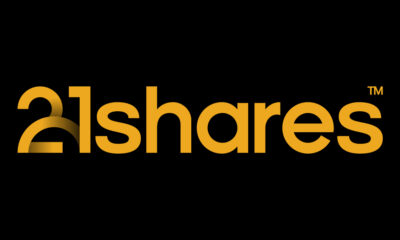
 Nyheter4 veckor sedan
Nyheter4 veckor sedanCrypto Market Risks & Opportunities: Insights on Bybit Hack, Bitcoin, and Institutional Adoption
-
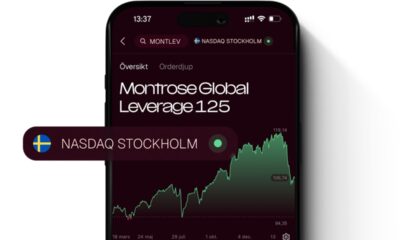
 Nyheter4 veckor sedan
Nyheter4 veckor sedanMontrose storsatsning på ETFer fortsätter – lanserar Sveriges första globala ETF med hävstång
-

 Nyheter4 veckor sedan
Nyheter4 veckor sedanSvenskarna har en ny favorit-ETF
-
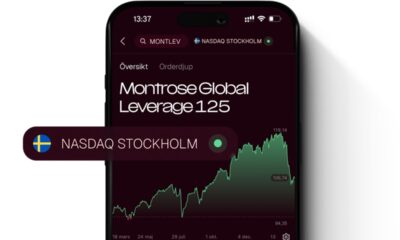
 Nyheter4 veckor sedan
Nyheter4 veckor sedanMONTLEV, Sveriges första globala ETF med hävstång
-

 Nyheter3 veckor sedan
Nyheter3 veckor sedanSju börshandlade fonder som investerar i försvarssektorn
-

 Nyheter3 veckor sedan
Nyheter3 veckor sedanVärldens första europeiska försvars-ETF från ett europeiskt ETF-företag lanseras på Xetra och Euronext Paris
-

 Nyheter4 veckor sedan
Nyheter4 veckor sedanEuropeisk försvarsutgiftsboom: Viktiga investeringsmöjligheter mitt i globala förändringar
-

 Nyheter3 veckor sedan
Nyheter3 veckor sedan21Shares bildar exklusivt partnerskap med House of Doge för att lansera Dogecoin ETP i Europa


